《Unit-10--I’d-like-some-noodles》教学设计
Unit 10 I’d like some noodles教案21
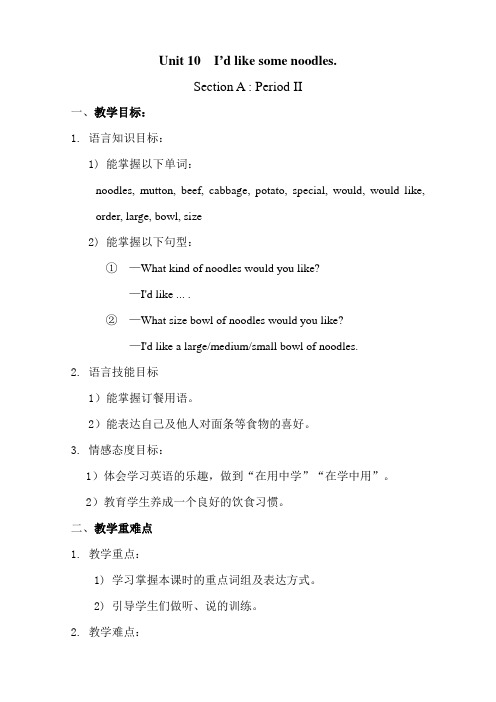
Unit 10 I’d like some noodles.Section A : Period II一、教学目标:1. 语言知识目标:1) 能掌握以下单词:noodles, mutton, beef, cabbage, potato, special, would, would like, order, large, bowl, size2) 能掌握以下句型:①—What kind of noodles would you like?—I'd like ... .②—What size bowl of noodles would you like?—I'd like a large/medium/small bowl of noodles.2. 语言技能目标1)能掌握订餐用语。
2)能表达自己及他人对面条等食物的喜好。
3. 情感态度目标:1)体会学习英语的乐趣,做到“在用中学”“在学中用”。
2)教育学生养成一个良好的饮食习惯。
二、教学重难点1. 教学重点:1) 学习掌握本课时的重点词组及表达方式。
2) 引导学生们做听、说的训练。
2. 教学难点:1) 能询问和回答对面条等食物的喜好并掌握如何订餐等用语。
2) 引导学生将所学的知识运用于实践三、教学过程Ⅰ. Warming-up and lead-in1. Watch a video program about food and vegetables.2. Ask and answer:What's your favorite food/vegetables?Why do people like to eat noodles on their birthday?Ⅱ. Presentation1.Show some pictures of food on PPT and present some new words.2. Show some pictures of noodles on PPT and ask Ss “What kind of noodles is it? ” And lead Ss to answer “It’s tomato and egg noodles”.3. Explain to Ss the usage of the part underlined.It’s beef and tomato noodles.It’s mutton and potato noodles.It’s chicken, cabbage and egg noodlesⅢ. PairworkShow some pictures of vegetables on PPT1) Ask one student and ask and answer like this:---- What kind of noodles would you like?---- I’d like ... noodles.2) Let Ss make conversations like this:---- What kind of noodles would you like?---- I’d like ... noodles.Ⅳ. Memory GameGive Ss three minutes to remember the following sentences:I’d like ... noodles.beefbeef and potatobeef potato and cabbagebeef potato cabbage and muttonbeef potato cabbage mutton and tomatoⅤ. Presentation1) Show some pictures of different sizes of bowls on PPT and present the new words.2) Present the structure:---- What size would you like?---- I’d like a large/medium/small bowl.Ⅵ. Guessing GameShow some pictures of noodles and let Ss guess what kind of noodles they are and what size bowl of noodles it is. 1. Ask and answer questions with your partner. Use the information in 2a.Ⅶ. Listening1)Work on 2a: Let Ss look at the pictures on the right and say out what food there are and then let Ss listen to the conversations and check the names of the foods they hear. Finally, check the answers together.2)Work on 2b: Let Ss just listen for the first time and write down the words for the second time. Finally, ask Ss to give the answers individually.3)Let Ss repeat the conversations one sentence by one sentence.Ⅷ. Practice1) Let Ss ask and answer using the information in 2a.----What kind of noodles would he/she like?----She/He would like ... Noodles.----What size would he/she like?----He/She would like a ... Bowl.2) Show some pictures of movie stars, bowls and noodles and let Ss make conversations according to the pictures.----What kind of noodles would Zhou Jielun like?----He would like ... Noodles.----What size would he like?----He/She would like a ... Bowl.IX. Group Work1) Let Ss ask their group members the following questions:----What kind of noodles would you like ?----What size would you like ?2) Ask several Ss to make a report:Tom would like mutton and cabbage noodles. He’d like a medium bowl of noodles. ...X. Homework1) Give a piece of advice: It is good for you to have a good eating habit; to eat more fruit and vegetables; to eat less meat2) Let Ss ask their family members the following questions and then make a report.----What kind of noodles would you like?----What size would you like?板书设计:。
最新七年级英语下册 Unit 10 I’d like some noodles教案 (新版)人教新目标版
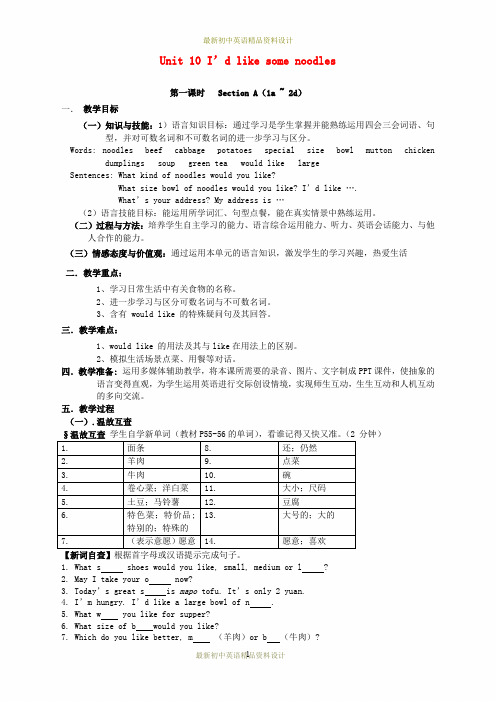
Unit 10 I’d like some noodles第一课时 Section A(1a ~ 2d)一.教学目标(一)知识与技能:1)语言知识目标:通过学习是学生掌握并能熟练运用四会三会词语、句型,并对可数名词和不可数名词的进一步学习与区分。
Words: noodles beef cabbage potatoes special size bowl mutton chicken dumplings soup green tea would like largeSentences: What kind of noodles would you like?What size bowl of noodles would you like? I’d like ….What’s your address? My address is …(2)语言技能目标:能运用所学词汇、句型点餐,能在真实情景中熟练运用。
(二)过程与方法:培养学生自主学习的能力、语言综合运用能力、听力、英语会话能力、与他人合作的能力。
(三)情感态度与价值观:通过运用本单元的语言知识,激发学生的学习兴趣,热爱生活二.教学重点:1、学习日常生活中有关食物的名称。
2、进一步学习与区分可数名词与不可数名词。
3、含有 would like 的特殊疑问句及其回答。
三.教学难点:1、would like 的用法及其与like在用法上的区别。
2、模拟生活场景点菜、用餐等对话。
四.教学准备:运用多媒体辅助教学,将本课所需要的录音、图片、文字制成PPT课件,使抽象的语言变得直观,为学生运用英语进行交际创设情境,实现师生互动,生生互动和人机互动的多向交流。
五.教学过程(一).温故互查§温故互查学生自学新单词(教材P55-56的单词),看谁记得又快又准。
(2 分钟)1. 面条8. 还;仍然2. 羊肉9. 点菜3. 牛肉10. 碗4. 卷心菜;洋白菜11. 大小;尺码5. 土豆;马铃薯12. 豆腐13. 大号的;大的6. 特色菜;特价品;特别的;特殊的7. (表示意愿)愿意14. 愿意;喜欢【新词自查】根据首字母或汉语提示完成句子。
Unit 10 I’d like some noodles 教学设计
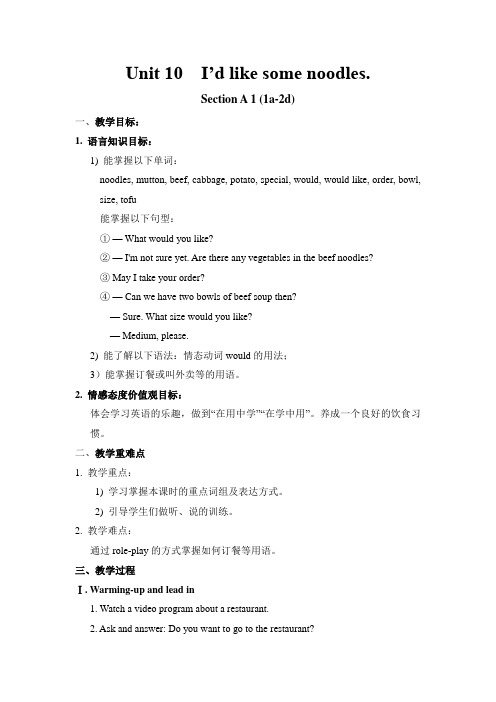
Unit 10 I’d like some noodles.Section A 1 (1a-2d)一、教学目标:1. 语言知识目标:1) 能掌握以下单词:noodles, mutton, beef, cabbage, potato, special, would, would like, order, bowl, size, tofu能掌握以下句型:①— What would you like?②— I'm not sure yet. Are there any vegetables in the beef noodles?③ May I take your order?④— Can we have two bowls of beef soup then?— Sure. What size would you like?— Medium, please.2) 能了解以下语法:情态动词would的用法;3)能掌握订餐或叫外卖等的用语。
2. 情感态度价值观目标:体会学习英语的乐趣,做到“在用中学”“在学中用”。
养成一个良好的饮食习惯。
二、教学重难点1. 教学重点:1) 学习掌握本课时的重点词组及表达方式。
2) 引导学生们做听、说的训练。
2. 教学难点:通过role-play的方式掌握如何订餐等用语。
三、教学过程Ⅰ. Warming-up and lead in1. Watch a video program about a restaurant.2. Ask and answer: Do you want to go to the restaurant?What food would you like?Ⅱ. Presentation1. (show some pictures of food on the big screen)Present some new words and expressions to the Ss.2. Ss learn the new words and expressions by themselves and try to remember them.3. Work on 1a:Read the words on the left and look at the pictures on the right. Write the letters of the food on the line. Then check the answers.Ⅲ. Game (Guess the food.)(Show some pictures of food on the big screen)Let Ss guess what food it is.Ss try to guess the food and learn the words.Ⅳ. ListeningT: In the following conversation, one man is ordering some food. Now, let’s listen to the tape, find out the right noodles the person orders.Play the recording for the Ss to listen and check the answers.Ⅴ. Pair work1. Present the conversation in 1b on the big screen and ask Ss to practice it.2. Make their own conversations using the noodles in the picture.3. Let some pairs act out their conversations.Ⅵ. Listening1. Work on 2a;T: Now, look at the pictures on the right, listen to the conversations and checkthe names of the foods you hear.(Play the recording for the first time, students only listen carefully.Then, listen to the recording again, and check the names of the foods.Check the answers. )2. Work on 2b:(Play the recording for the Ss to listen and complete the sentences.)Play the recording twice. The first time Ss just listen. And the second time, Ss listen and write down the words.3. Check the answers.Ⅶ. Pair work1. Ask and answer questions with your partner. Use the information in 2a.2. Show the conversations of 2a on the big screen to the Ss.3. Make a model for the Ss.T: What kind of noodles would you like?S1: I'd like beef noodles, please.…3. Ss work in pairs and practice the conversations.Ⅷ. Role-play1. Ask Ss to read the conversation in 2d and find the answer to this question:What would they like?(They would like one large bowl of beef soup, one gongbao chicken, and onemapo tofu with rice.)2. Check the answers with the Ss.3. Ss work with their partners and role-play the conversation.VIII. Language pointsIX. ExercisesHomework1. Review the words and expressions in this period.2. Role-play the conversation in 2d.3. Write a short conversation to order some noodles you like in a restaurant.板书设计:Unit 10 I’d like some noodles.Section A 1 (1a-2d)①—What would you like?②—I'm not sure yet. Are there any vegetables in the beef noodles?③May I take your order?④—Can we have two bowls of beef soup then?—Sure. What size would you like?—Medium, please.教学反思:本节课通过观看饭店视频和食物图片,导入新课。
七年级英语下册 Unit 10 I'd like some noodles教学设计(人教新目标版)

七年级英语下册Unit 10 I’d like some noodles教学设计(人教新目标版)一. 教材分析人教新目标版七年级英语下册Unit 10主要教授了关于餐厅用餐的日常对话。
通过本节课的学习,学生能够掌握如何点餐、描述食物和饮料以及表达喜好等语言技能。
教材通过丰富的情境、图片和对话,激发学生的学习兴趣,培养他们的交际能力。
二. 学情分析七年级的学生已经掌握了基本的英语语法和词汇,具备一定的听说读写能力。
他们对新事物充满好奇,善于模仿和互动。
然而,部分学生可能在实际口语交流中感到自信不足,需要教师给予更多的鼓励和指导。
三. 教学目标1.知识目标:学生能够掌握表示食物和饮料的词汇,如noodles,dumplings, rice, vegetable等;能够运用情态动词would like表达自己的喜好。
2.能力目标:学生能够在日常生活中用英语进行点餐和描述食物,提高他们的口语交际能力。
3.情感目标:培养学生热爱美食,养成良好的饮食习惯。
四. 教学重难点1.重点:掌握表示食物和饮料的词汇,运用情态动词would like进行点餐和描述食物。
2.难点:正确使用情态动词would like,并在实际语境中进行运用。
五. 教学方法1.情境教学法:通过设置餐厅用餐的情境,激发学生的学习兴趣,提高他们的口语交际能力。
2.交际法:引导学生进行角色扮演,模拟实际生活中的点餐场景,培养他们的实际应用能力。
3.任务型教学法:通过完成各种任务,如小组讨论、游戏等,巩固所学知识。
六. 教学准备1.教师准备:制作多媒体课件,包括餐厅图片、食物和饮料的词汇卡片等。
2.学生准备:预习本节课的生词和句子,了解餐厅用餐的基本礼仪。
七. 教学过程1.导入(5分钟)教师通过展示餐厅的图片,引导学生谈论他们喜欢的食物和饮料。
同时,教师询问学生:“Would you like something to eat or drink?”,让学生回答:“Yes, please./No, thank you.”,从而引出本节课的主题。
Unit 10 I’d like some noodles教案

Unit 10 I’d like some noodles.Section A 1 (1a-1c)一、教学目标:1. 1) 能掌握以下单词:noodles, mutton, beef, cabbage, potato, special, would, would like能掌握以下句型:①— What would you like?②— I'm not sure yet. Are there any vegetables in the beef noodles?③— I’d like...2) 能了解以下语法:情态动词would的用法;2. 体会学习英语的乐趣。
养成一个良好的饮食习惯。
二、教学重难点1. 教学重点:1) 学习掌握本课时的重点词组及表达方式。
2) 引导学生们做听、说的训练。
2. 教学难点:通过role-play的方式掌握如何订餐等用语。
三、教学过程Learning objectives●To learn to use would like●To learn to use some and any●To learn food names: noodles, beef, mutton, chicken, tomatoes…●To learn to distinguish and use countable and uncountable nouns about food Step 1. Warmingup1.Watch a video about A Bite of China.2.Enjoy some traditional food in China and Shaoyang.3.T: What's your favorite food/drink?Do you like noodles?What kind of noodles do you like?Step 2. Presentation1. (show some pictures of food on the big screen)Present some new words and expressions to the Students.2. Students learn the new words and expressions by themselves and try to remember them.3. Work on 1a:Read the words on the left and look at the pictures on the right. Write the letters of the food on the line. Then check the answers.1. mutton __2. beef __3. noodles __4. chicken __5. cabbage __6. potatoes __7. tomatoes __8. carrots __Step 3. PresentationWork in pairs to practice the sentences.—What would you…?—I’d like…Step 4. Listening1. T: In the following conversation, one man is ordering some food. Now, let’slisten to the tape, find out the right noodles the person orders.____ Special 1 ____ Special 2 ____ Special 32. Play the recording for the Ss to listen and check the answers.3. Listen and complete the conversation.Waitress: ____________________?Boy: I’m not sure yet. Are there any vegetables in the ___________ ?Waitress: Yes, there are some _________.Boy: OK, I’d like the ___________, please.Step 5. Pair workWork on 1c.1. Make their own conversations using the noodles in the picture.2. Let some pairs act out their conversations.Step 6. Pair work1. Ask and answer questions with your partner. Use the information in 2a.2. Show the conversations of 2a on the big screen to the Ss.3. Make a model for the Ss.T: What kind of noodles would you like?S1: I'd like beef noodles, please.Step 7. Summary- What kind of … would you like?- I’d like …, please.- What size would you like?-I’d like a sm all/medium/large bowl, please.- Is /Are there any … in the …?- Yes, there .../ No, there ...May I take / have your order?Step 8. ExercisesⅠ. 根据句意及所给图片提示,写出句中所缺单词。
七年级英语下册《Unit 10 I'd like some noodles》教案
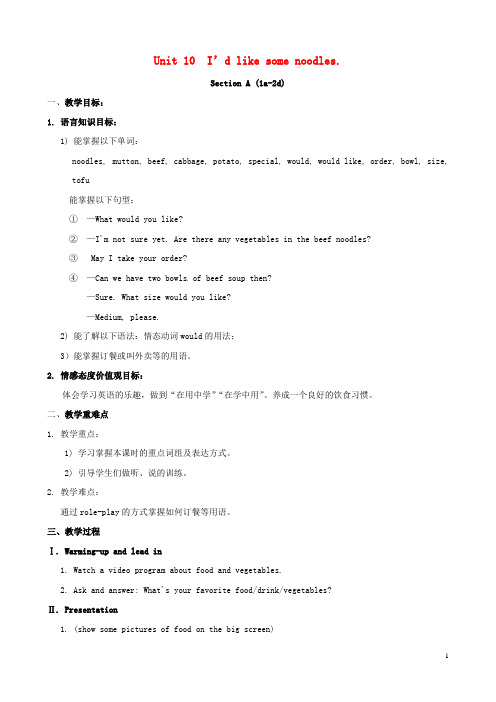
Unit 10 I’d like some noodles.Section A (1a-2d)一、教学目标:1. 语言知识目标:1) 能掌握以下单词:noodles, mutton, beef, cabbage, potato, special, would, would like, order, bowl, size, tofu能掌握以下句型:①—What would you like?②—I'm not sure yet. Are there any vegetables in the beef noodles?③ May I take your order?④—Can we have two bowls of beef soup then?—Sure. What size would you like?—Medium, please.2) 能了解以下语法:情态动词would的用法;3)能掌握订餐或叫外卖等的用语。
2. 情感态度价值观目标:体会学习英语的乐趣,做到“在用中学”“在学中用”。
养成一个良好的饮食习惯。
二、教学重难点1. 教学重点:1) 学习掌握本课时的重点词组及表达方式。
2) 引导学生们做听、说的训练。
2. 教学难点:通过role-play的方式掌握如何订餐等用语。
三、教学过程Ⅰ. Warming-up and lead in1. Watch a video program about food and vegetables.2. Ask and answer: What's your favorite food/drink/vegetables?Ⅱ. Presentation1. (show some pictures of food on the big screen)Present some new words and expressions to the Ss.2. Ss learn the new words and expressions by themselves and try to remember them.3. Work on 1a:Read the words on the left and look at the pictures on the right. Write the letters of the food on the line. Then check the answers.Ⅲ. Ga me (Guess the food.)(Show some pictures of food on the big screen)Let Ss guess what food it is.Ss try to guess the foo d and learn the words.Ⅳ. ListeningT: In the following conversation, one man is ordering some food. Now, let’s listen to the tape, find out the right noodles the person orders.Play the recording for the Ss to listen and check the answers.Ⅴ. Pair work1. Present the conversation in 1b on the big screen and ask Ss to practice it.2. Make their own conversations using the noodles in the picture.3. Let some pairs act out their conversations.Ⅵ. Listening1. Work on 2a;T: Now, look at the pictures on the right, li sten to the conversations and check the names of the foods you hear.(Play the recording for the first time, students only listen carefully.Then, listen to the recording again, and check the names of the foods.Check the answers. )2. Work on 2b:(Play the recording for the Ss to listen and complete the sentences.)Play the recording twice. The first time Ss just listen. And the second time, Ss listen and write down the words.(If necessary, use the pause button to help Ss)3. Check the a nswers.Ⅶ. Pair work1. Ask and answer questions with your partner. Use the information in 2a.2. Show the conversations of 2a on the big screen to the Ss.3. Make a model for the Ss.T: What kind of noodles would you like?S1: I'd like beef noodles, please.…3. Ss work in pairs and practice the conversations.Ⅷ. Role-play1. Ask Ss to read the conversation in 2d and find the answer to this question:What would they like?(They would like one large bowl of beef soup, one gongbao chicken, and one mapo tofu with rice.)2. Check the answers with the Ss.3. Ss work with their partners and role-play the conversation.VIII. Language pointsIX. ExercisesHomework1. Review the words and expressions in this period.2. Role-play the conversation in 2d.3. Write a short conversation to order some noodles you like in a restaurant.板书设计:Section A (Grammar Focus-3c)一、1. 语言知识目标:1) 继续练习运用如何订餐或叫外卖等的用语。
英语:七年级下Unit 10 I’d like some noodles教案第三课时
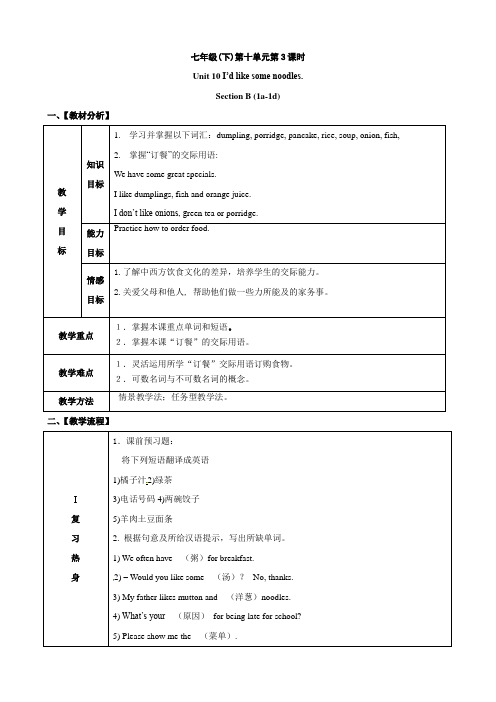
七年级(下)第十单元第3课时Unit 10 I’d like some noodles.Section B (1a-1d)一、【教材分析】教学目标知识目标1.学习并掌握以下词汇:dumpling, porridge, pancake, rice, soup, onion, fish,2.掌握“订餐”的交际用语:We have some great specials.I like dumplings, fish and orange juice.I don’t like onions, g reen tea or porridge.能力目标Practice how to order food.情感目标1.了解中西方饮食文化的差异,培养学生的交际能力。
2.关爱父母和他人, 帮助他们做一些力所能及的家务事。
教学重点1.掌握本课重点单词和短语。
2.掌握本课“订餐”的交际用语。
教学难点1.灵活运用所学“订餐”交际用语订购食物。
2.可数名词与不可数名词的概念。
教学方法情景教学法;任务型教学法。
二、【教学流程】Ⅰ复习热身1.课前预习题:将下列短语翻译成英语1)橘子汁2)绿茶3)电话号码4)两碗饺子5)羊肉土豆面条2. 根据句意及所给汉语提示,写出所缺单词。
1) We often have (粥)for breakfast.2) – Would you like some (汤)?- No, thanks.3) My father likes mutton and (洋葱)noodles.4) What’s your (原因)for being late for school?5) Please show me the (菜单).检查生词预习:1) 正音P112 让个别学生朗读生词,教师及时正音,然后领读、齐读。
2) 听写生词。
四人一组爬黑板,其余的学生以学习小组为单位听写,然后互批互改,小组长汇报检查情况。
对优者提出表扬,表现差者要帮助学生识记生词。
七年级英语教学设计:Unit-10-I'd-like-some-noodles(第2课时)(新人教版下册)
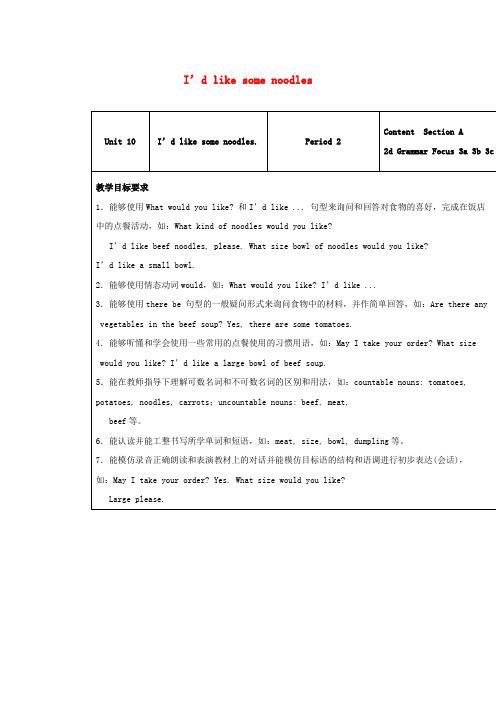
There are three cabbages on the table, but there isn’t any
cabbage in the soup.引导学生在句中、上下文中去感知、感
学生双人活动,教师抽查几对学生。
导入
时间
1 m
3
导入新课话题
T: Well, let’s go on with another conversation.
4
引入单元标题
教师板书:
Unit 10 I’d like some noodles. Section A
2d
时间
8 m
5
读图,了解对话情景、地点、人物和谈论的话题
beef等。
6.能认读并能工整书写所学单词和短语,如:meat, size, bowl, dumpling等。
7.能模仿录音正确朗读和表演教材上的对话并能模仿目标语的结构和语调进行初步表达(会话),
如:May I take your order? Yes. What size would you like?
S: I am not sure yet. Are there any vegetables in beef noodles?
T: Yes, there are some tomatoes.
S: I’d like beef noodles.
2
仿照上述对话,组织Pair-work复习活动
T: OK. Let’s do pair-work: Talk about your last weekend.
3.能够使用there be句型的一般疑问形式来询问食物中的材料,并作简单回答,如:Are there any
人教版新目标英语七年级下册《Unit 10 I’d like some noodles》优质课教学设

人教版新目标英语七年级下册《Unit 10 I’d like some noodles》优质课教学设计一. 教材分析人教版新目标英语七年级下册《Unit 10 I’d like some noodles》主要介绍了日常生活中的食物和饮料。
本节课以食物和饮料为主题,通过学习让学生能够熟练运用一般现在时表达喜好,并能够进行简单的购物交流。
本节课的主要内容有:食物和饮料的词汇,一般现在时的表达方式,以及如何用英语进行购物。
二. 学情分析七年级的学生已经掌握了基本的英语语法和词汇,具备一定的听、说、读、写能力。
但是,对于一些食物和饮料的词汇以及一般现在时的运用可能还不够熟练。
因此,在教学过程中,需要注重词汇的教学和语法点的讲解,同时,引导学生进行实际操作,提高他们的实际运用能力。
三. 教学目标1.知识目标:学生能够掌握本节课的食物和饮料词汇,理解一般现在时的表达方式,并能够运用所学知识进行简单的购物交流。
2.能力目标:学生能够听、说、读、写本节课的词汇和句型,提高他们的英语表达能力。
3.情感目标:通过本节课的学习,学生能够培养对英语的兴趣,增强自信心,提高合作意识。
四. 教学重难点1.重点:食物和饮料的词汇,一般现在时的表达方式。
2.难点:一般现在时的运用,购物场景的交流。
五. 教学方法采用任务型教学法,情境教学法,分组合作学习法,以及游戏教学法等多种教学方法,激发学生的学习兴趣,提高他们的参与度和积极性。
六. 教学准备1.教师准备:准备好食物和饮料的图片、实物,以及相关的教学材料。
2.学生准备:预习本节课的词汇和句型,准备好笔记本和文具。
七. 教学过程1.导入(5分钟)教师通过展示一些食物和饮料的图片,引导学生进行观察和思考,激发他们的学习兴趣。
然后,询问学生他们喜欢什么食物和饮料,引出本节课的主题。
2.呈现(10分钟)教师展示本节课的食物和饮料词汇,以及一般现在时的表达方式,引导学生进行观察和理解。
《Unit-10--I’d-like-some-noodles》教学设计

2. Let Ss try to remember the new words and expressions.
Let Ss remember the new words and phrases.
I don’t like …, …or….
②What kind of dumplings would you like?
③Would you like any drinks?
(2).语言技能目标:
能运用所学词汇、句型点餐,能在真实情景中熟练运用。
2、过程与方法目标:
培养学生自主学习的能力、语言综合运用能力、听力、英语会话能力、与他人合作的能力。
Ⅲ. Pair work
1. Let Ss works in groups. Talk about the things they like in 1a. Put aхnext to the things they don’t like.Then tell their partners what they like and don't like.
Sa: I like dumplings, but I don't like noodles.
Sb: Well, I like fish but I don't like meat.
2. Work in groups. Talk about what you like and what you don’t like.
四、教学策略选择与设计
在课堂活动中把学生分成四人小组的学习小组,让他们围绕着课堂任务分工合作,在活动中相互探讨、相互交流、相互合作,从而获得知识、技能和情感体验,发展他们的能力。
Unit10《I’d-like-some-noodles》教学设计精选全文完整版

可编辑修改精选全文完整版Unit10《I’d like some noodles》教学设计一、教材分析本堂课是针对七年级下册Unit 10I’d like some noodles而展开的,本课的阅读部分重点介绍了世界各地的生日饮食习惯,学生不仅要学会说语言,更要了解语言背后的文化知识,同时需要结合本课所学句型进行对话练习;此外,初中英语教学的最高境界是渗透多元文化视域,让学生以中国文化作为精神依附,有针对性地借鉴外国优秀文化成果,从而使英语教学在动态、连续的发展过程中顺应时代需求,针对本课饮食文化教学内容来说,学生需要善于捕捉时事热点,在后疫情时代,各国促生了新的礼节方式,英语课堂要引导学生了解疫情下各国的风俗礼仪,增加学生的文化积累,让学生在具体交际时能使用正确的用语和礼节,这也降低了跨文化交际错误的产生。
二、教学目标各国文化在世界范围内各自发展,文化多元化不是各国文化的相互同化或逐渐趋同,而是随着世界政治经济的高速发展,各国文化在相互吸收的基础上形成的一种相互交叉的生活方式。
本课也将从多元文化视域的角度出发,制定“多样化”的课堂设计,旨在激发学生的学习兴趣,补充生活体验,让学生的思维得到发散。
具体课堂目标设计如下:1. 知识领域:学生能够运用和掌握以下词汇:around the world、different、lucky、popular、candle、age等,掌握与饮食有关的表达、生日食品的含义;2.技能领域:运用思维导图简要复述文章大意,进行口头语段及语篇表达,并将其运用于个人讲述、集体讨论及课外采访中来。
3.情感领域:通过相关材料的学习与训练,深入体会中西方饮食文化的差异,体验生日文化气息,最终能在真实的跨文化交际中进行比较深入、得体的交流。
三、教学重难点1.教学重点:熟练掌握本课的重点单词和短语make a wish, blow out等,并了解中西方生日、饮食文化的差异;2.教学难点:学生需要掌握本课的重要语法点:the number of 与 anumber of的差别,if引导的条件状语从句,区别可数名词与不可数名词;四、教学准备基于创新教育的大背景下,教师需要在现代教育技术基础上重新审视各专业的特点,教学方式和策略也需要对照标准进一步更新,目前现代教育技术与英语教学跨领域融合的模式也给教学发展带来了新的机遇和挑战,本课教学中就采用了混合式教学模式,促进线上线下教学的相互融通,使现代教育技术与英语教学相融合。
Unit 10 I'd like some noodles教案

Unit 10 I’d like some noodles、Section A 1 (1a-2d)一、教学目标:1、语言知识目标:1) 能掌握以下单词:noodles, mutton, beef, cabbage, potato, special, would, would like, order, bowl, size, tofu能掌握以下句型:①— What would you like?②— I'm not sure yet、Are there any vegetables in the beef noodles?③ May I take your order?④— Can we have two bowls of beef soup then?— Sure、What size would you like?— Medium, please、2) 能了解以下语法:情态动词would的用法;3)能掌握订餐或叫外卖等的用语。
2、情感态度价值观目标:体会学习英语的乐趣,做到“在用中学”“在学中用”。
养成一个良好的饮食习惯。
二、教学重难点1、教学重点:1) 学习掌握本课时的重点词组及表达方式。
2) 引导学生们做听、说的训练。
2、教学难点:通过role-play的方式掌握如何订餐等用语。
三、教学过程Ⅰ、Warming-up and lead in1、Watch a video program about food and vegetables、2、Ask and answer: What's your favorite food/drink/vegetables?Ⅱ、Presentation1、(show some pictures of food on the big screen)Present some new words and expressions to the Ss、2、Ss learn the new words and expressions by themselves and try to remember them、3、Work on 1a:Read the words on the left and look at the pictures on the right、Write the letters of the food on the line、Then check the answers、Ⅲ、Game (Guess the food、)(Show some pictures of food on the big screen)Let Ss guess what food it is、Ss try to guess the food and learn the words、Ⅳ、ListeningT: In the following conversation, one man is ordering some food、Now, let’s listen to the tape, find out the right noodles the person orders、Play the recording for the Ss to listen and check the answers、Ⅴ、Pair work1、Present the conversation in 1b on the big screen and ask Ss to practice it、2、Make their own conversations using the noodles in the picture、3、Let some pairs act out their conversations、Ⅵ、Listening1、Work on 2a;T: Now, look at the pictures on the right, listen to the conversations and check the names of the foods you hear、(Play the recording for the first time, students only listen carefully、Then, listen to the recording again, and check the names of the foods、Check the answers、)2、Work on 2b:(Play the recording for the Ss to listen and complete the sentences、)Play the recording twice、The first time Ss just listen、And the second time, Ss listen and write down the words、(If necessary, use the pause button to help Ss)3、Check the answers、Ⅶ、Pair work1、Ask and answer questions with your partner、Use the information in 2a、2、Show the conversations of 2a on the big screen to the Ss、3、Make a model for the Ss、T: What kind of noodles would you like?S1: I'd like beef noodles, please、…3、Ss work in pairs and practice the conversations、Ⅷ、Role-play1、Ask Ss to read the conversation in 2d and find the answer to this question:What would they like?(They would like one large bowl of beef soup, one gongbao chicken, and one mapo tofu with rice、)2、Check the answers with the Ss、3、Ss work with their partners and role-play the conversation、VIII、Language pointsIX、ExercisesHomework1、Review the words and expressions in this period、2、Role-play the conversation in 2d、3、Write a short conversation to order some noodles you like in a restaurant、板书设计:Section A 2 (Grammar Focus-3c)一、教学目标:1、语言知识目标:1) 继续练习运用如何订餐或叫外卖等的用语。
Unit-10-I'd-like-some-noodles.教案 (1)
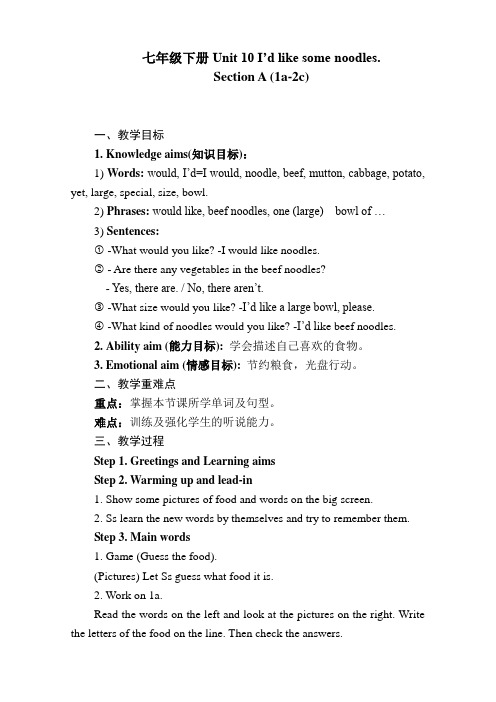
七年级下册Unit 10 I’d like some noodles.Section A (1a-2c)一、教学目标1. Knowledge aims(知识目标):1) Words: would, I’d=I would, noodle, beef, mutton, cabbage, potato, yet, large, special, size, bowl.2) Phrases:would like, beef noodles, one (large) bowl of …3) Sentences:① -What would you like? -I would like noodles.② - Are there any vegetables in the beef noodles?- Yes, there are. / No, there aren’t.③ -What size would you like? -I’d like a large bowl, please.④ -What kind of noodles would you like? -I’d l ike beef noodles.2. Ability aim (能力目标): 学会描述自己喜欢的食物。
3. Emotional aim (情感目标): 节约粮食,光盘行动。
二、教学重难点重点:掌握本节课所学单词及句型。
难点:训练及强化学生的听说能力。
三、教学过程Step 1. Greetings and Learning aimsStep 2. Warming up and lead-in1. Show some pictures of food and words on the big screen.2. Ss learn the new words by themselves and try to remember them.Step 3. Main words1. Game (Guess the food).(Pictures) Let Ss guess what food it is.2. Work on 1a.Read the words on the left and look at the pictures on the right. Write the letters of the food on the line. Then check the answers.Step 4. ListeningT: In the following conversation, one man is ordering some food. Now, let’s listen to the tape, find out the right noodles the person orders.Play the recording for the Ss to listen and check the answers.Step 5. Pair work1. Present the conversation and ask Ss to practice it.2. Make their own conversations using the noodles in the picture.3. Let some pairs act out their conversations.Step 6. Listening1. Work on 2a.Play the recording for the first time, students only listen carefully. Then, listen to the recording again, and check the names of the foods. Check the answers.2. Work on 2b.Play the recording twice. The first time Ss just listen. And the second time, Ss listen and write down the words.(If necessary, use the pause button to help Ss)3. Check the answers.Step 7. Pair work1. Show the conversations of 2a on the big screen to the Ss.2. Ss work in pairs and practice the conversations.Step 8. Summary and QuizStep 9. Video and Homework1. Review the words and expressions in this period.2. Save food from now on.四、板书设计。
- 1、下载文档前请自行甄别文档内容的完整性,平台不提供额外的编辑、内容补充、找答案等附加服务。
- 2、"仅部分预览"的文档,不可在线预览部分如存在完整性等问题,可反馈申请退款(可完整预览的文档不适用该条件!)。
- 3、如文档侵犯您的权益,请联系客服反馈,我们会尽快为您处理(人工客服工作时间:9:00-18:30)。
通过创设人文情景,学生身临其境感受和体验,使语言学以致用,做到“在用中学,在学中用”,激发学生的学习积极性。体会在活动中学习英语的乐趣。培养学生乐于与他人合作的精神及养成科学的饮食习惯。
4、文化意识目标:
通过对中、西方在饮食及用餐方面异同的对比,对祖国饮食文化能有更深刻的了解。乐于了解异国文化,加强对文化差异的理解与认识。
5、学习策略目标:
通过学习,是学生在一定程度上形成自主学习、探究学习、合作学习的习惯,有效交际、用英语思维的能力。
6、教学工具:
录音机多媒体
三、学习者特征分析
对小学升入初中的初一学生来说,经历了三年基本的小学英语学习后,对英语的基本知识有了一个大概的了解。七年级是一个产生剧烈变化的时期,更是一个危险的时期,也是一个爬坡的时期,是一个分水岭。根据我长期的观察,本班基础差的学生较多,大部分学生须然在小学接触过英语,但应用能力十分薄弱,而且不正规的书写习惯已经形成,很难纠正。
四、教学策略选择与设计
在课堂活动中把学生分成四人小组的学习小组,让他们围绕着课堂任务分工合作,在活动中相互探讨、相互交流、相互合作,从而获得知识、技能和情感体验,发展他们的能力。
五、教学重点及难点
1.教学重点:
1)通过进行听、说的训练,来提高学生们综合运用所学知识的能力。
2)通过读、写的训练,来让学生们能真正在实际活动中运用所学的知识。
另外,学生在情感态度、学习策略和文化意识方面存在诸多需要进一步解决的问题。例如:个别学生不明确学习英语的目的;有些同学对学好英语没有自信,不敢用英语表达。缺乏小组合作,一些学生没有养成良好的学习习惯,不能做好课前预习课后复习,学习没有计划性和策略性;不善于总结和发现语言规律,不注意知识的巩固和集累。
1. Ss learn the new words and expressions by themselves and try to remember them.
2. Let Ss try to remember the new words and expressions.
Let Ss remember the new words and phrases.
Unit 10 I’d like some noodles.教学设计与反思
课题:Unit 10 I’d like some noodles.(Section B 1a-1d)
科目:英语
教学对象:七年级112班
课时:第四课时
提供者:
一、教学内容分析
本节课的教学活动知识实用性比较强,课堂中加强了口语练习,通过反复练习,需要达到熟练掌握的目的。教师指导学生如何运用所学知识做题,如何思考。这个节课知识的难度加深了,重要的词组句子多了。因此,在情景交际中,教师应该鼓励学生真实再现生活中的情境,调动学生的积极性,对学生进行适时的评价。
Present some new words and expressions to the Ss.
2. Work on1a:
Read the words in the chart and look at the pictures below. Write the letters of the foods or drinks on the line. Then check the answers.
二、教学目标
1、知识与能力目标:
(1).语言知识目标:
1)能掌握以下单词:meat, dumpling, porridge, green tea, orange juice, soup, onion, fish, pancake
2)能掌握以下句型:
①A: What do you like ?
B: I like …, … and …
2. Let Ss make a list of things everyone likes and dislikes their groups.
3. Let some Ss give their report.
1. Circle the things you like in 1a. Put aхnext to the things you don’t like.Then tell you partner what you like and don't like.
I don’t like …, …or….
②What kind of dumplings would you like?
③Would you like any drinks?
(2).语言技能目标:
能运用所学词汇、句型点餐,能在真实情景中熟练运用。
2、过程与方法目标:
培养学生自主学习的能力、语言综合运用能力、听力、英语会话能力、与他人合作的能力。
2.教学难点
听力训练
六、教学过程
教师活动
学生活动
设计意图
Ⅰ. Warming- up
Let’s take a dictation and learn.
Take a .
Review the words.
Ⅱ. Presentation
1. (show some pictures of food on the big screen)
3. Make a list of things everyone likes and dislikes in your group. Then give a report to your classmates:
Sa: I like dumplings, but I don't like noodles.
Sb: Well, I like fish but I don't like meat.
2. Work in groups. Talk about what you like and what you don’t like.
Ⅲ. Pair work
1. Let Ss works in groups. Talk about the things they like in 1a. Put aхnext to the things they don’t like.Then tell their partners what they like and don't like.
